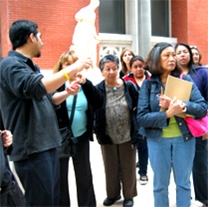Grant Spotlight | December 1, 2009
Share This |
Recipient: |
Contacts: |
||
When the Queens Museum of Art wanted to create an arts education program for immigrant adults, its location in the nation’s most diverse county played a big role in the process. Queens, New York, has a population of 2.2 million, 48 percent of whom are foreign born. Approximately 138 languages are spoken, and 55 percent of people age five years and older speak a language other than English at home. Of the total population, 26 percent is Hispanic, 21 percent is non-Hispanic Asian, and 18 percent is non-Hispanic Black or African-American. This diversity led the museum to look beyond its peers for an educational model.
Lauren Schloss, director of education at the museum and project director, said, "We couldn’t find a model or a partner through an art museum, but the Queens Library is one of the most successful cultural organizations in our borough. We learned that they had had a program called the New Americans Program for about 30 years. It focused on the same population—immigrant communities—with a bent toward adult education." So the museum enlisted Queens Library as a partner to help develop the "Art and Literacy for New New Yorkers" grant project. The library is the most heavily used library system in the country, with more than 21 million items circulated in 2007. It consists of 62 branches, seven Adult Learning Centers, and a central library.
In 2005, the museum received a three-year, $449,000 grant for Art and Literacy from the IMLS National Leadership Grants for Museums program. The project partners matched the IMLS award to maximize the grant’s impact.
Offering Classes
The project’s main objective was to provide arts, technology, and language programming to immigrant audiences, with the goal of making both the museum and the library indispensable community resources. To accomplish this, the partners crafted workshops and other professional development activities to train museum and library staff on the challenges of attracting and providing programs for immigrant populations. They also created and delivered a full range of jointly-sponsored educational and public programming for new Americans and designed and built a Cyber Center at the museum.
Library staff taught the professional development sessions, which focused on the keys to success in working with immigrant communities.
The library already had significant experience with cultural programming for immigrants, and it knew the county inside and out. "We have a long history of doing demographics," said Maureen O’Connor, the library’s chief operating officer. "We have a demographer on staff who can tell us what neighborhoods speak which languages. So, for example, if the museum was doing an exhibit of Southeast Asian artists, we could target neighborhoods where they might want to have an artist do a workshop."
The programming included classes in painting, book making, crafts, photography, video editing, performance, graphic design, Web design, computer literacy, arts literacy, and English for Speakers of Other Languages (ESOL). Most classes were held at the museum, although some started off at library branches. "For instance," Schloss said, "if we’re interested in offering a course in Korean, we’ll work with the library to see what would be an appropriate branch." The first month of the class would take place at the library branch and the second month at the museum—thus introducing people to the museum. The grant project also included performing arts events, open houses, and student art exhibits.
In addition, the partners created a space within the museum for a future library branch. This Reading Room was run by a librarian and contained 200 Queens Library reference books in four different languages.
Because of the large Latino community near the museum, many classes were offered in Spanish, but instructors also used English to accommodate non-Spanish-speakers from East Asia and elsewhere. Technology classes used the Cyber Center—a mobile computer lab with 15 laptops on a cart.
Educating People, Transforming Lives
The project had a large impact, providing 840 classes and events to 16,000 people during the grant period. Some 175 people took the ESOL classes; 267 attended the artists’ talks; 1,071 visitors and staff members used the Reading Room; and three open houses drew 1,100 people.
The classes were very popular. The Adobe PhotoShop course often had as many as 40 people, so students had to share computers. At one open house, 200 people signed up for a Web design class. The digital photography class in Spanish was very popular and is now offered at three different levels. In all, students completed 610 projects during the classes.
Schloss said, "One surprise was how popular the classes were. We went from having no idea what to do to just being completely oversubscribed and overwhelmed by demand."
The partners initially offered short classes, but they found that students wanted longer running instruction. In the project’s second year, the partners offered two-month-long classes in a studio art medium that usually included technology.
"Something we learned from the library early on," Schloss said, "was that skills were really important in the education experiences of adult immigrants in our community."
Three student art exhibitions were held at the museum, featuring 117 student projects.
The most notable result of the program, however, was the impact on students’ lives. The museum documented 20 cases of students who successfully transformed their lives and incomes with skills they learned in the Art and Literacy project.
For example, Celino B., a young man in his 20s from Mexico, took photography and video classes and now works as a social photographer on weekends. This supplements his income as a short-order cook. With this business, he can support his parents and younger siblings in Mexico and a younger brother here in the United States—thanks to Art and Literacy classes.
Challenges and Lessons Learned
One difficulty during the project was making the Reading Room more popular with visitors. It was not used as much as the partners expected. "Having literature in the gallery isn’t as popular as we all thought it would be," said Schloss. "But the items are noncirculating. We’re curious to see if they would be more relevant to people if they were circulating."
Plans for a satellite branch of Queens Library at the museum are still in the works; they were delayed along with the museum’s expansion project. Space has been allocated for a library branch, but design plans have not yet been created. It would be the first public library in an art museum in the country. "We intend for it to happen, but it’s still not confirmed," said Schloss.
The partnership was extremely smooth—the museum and the library found that they had more similarities than differences. One difference in working style did emerge when museum staff interacted with library staff and programmers at the branch level.
Schloss explained, "[Museum staff] tend to start from scratch and do a lot of brainstorming and thinking through things. We enjoy that process. On-the-ground staff at the library are more likely to say, ‘What’s the program? What kind of space do you need? When do you need it?’—so, more logistics." She said the museum easily adapted to the different work style. "So now we think things through with our staff and educators, then we contact the library. We’re more prepared when we start the conversation."
Fine-Tuning the Programs
After the grant ended, the budget for Art and Literacy shrank during its fourth year. Despite the dip, however, the museum staff continued to make inroads into the East Asian community. Schloss said, "One of the staff is fluent in Korean and another in Mandarin and Taiwanese, so they’ve been able to go much further with the community to the east of our museum."
The project now receives funding from the Altman Foundation and TD Commerce. Next steps include securing additional funding sources, fine-tuning the programming, and making progress on the library-inside-the-museum project.

